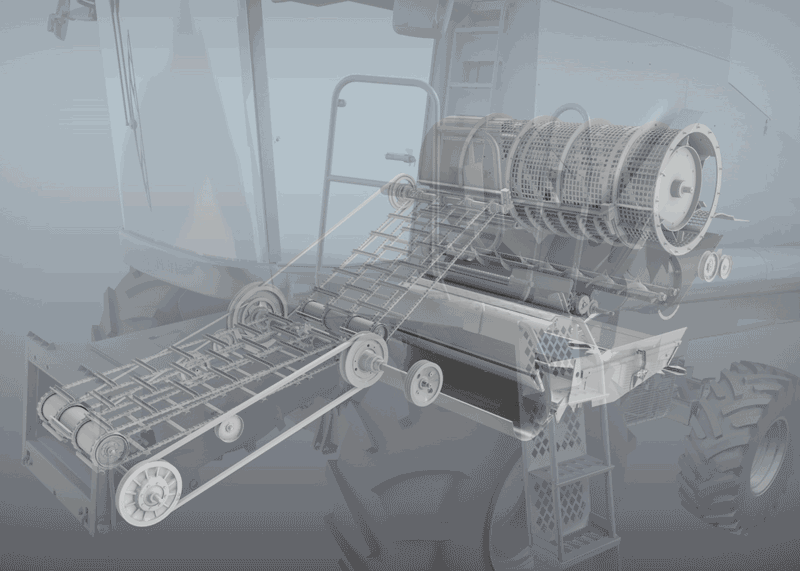Combine maintenance
PREPARING FOR HARVEST
AFTER MONTHS OF watching the weather forecast, scouting for insects, and battling weeds, it’s time for harvest and the whole other set of worries that accompany this busy time of year. To help put your mind at ease over one aspect of the season — machine readiness — two experts have offered their top tips to help you maximize efficiency and protect your combine during and after harvest. They both agree it is all about remembering the basics.
PHOTO: GLEANER NATURAL FLOWTM FEEDING AND THRESHING SYSTEM.

DO A WALK-AROUND AND INSPECT YOUR COMBINE
Before you start harvesting, take the time to walk around your combine and do a thorough inspection. Are all of the belts tight and free of cracks? Is there proper tension on all of the chains? Are the pulleys working right? Do you see any components that are looking a little worn down? How about where the crop touches the machine — are those edges good and sharp?
“Worn chopper knives can reduce the quality of chop and discharge, while increasing the horsepower requirement and fuel consumption,” explains Joshua Ekholm, a factory and field marketing specialist for combines with AGCO. “To maximize your efficiency, one successful process we’ve seen from producers is simply taking note of any potential concern areas with their combines at the completion of harvest, which they can use themselves or pass on to their dealership to ensure the following harvest is efficient and the downtime is minimal.”
Following inspection, Ekholm recommends engaging your feed house and processor, and running your combine empty for an hour or so, listening for anything that requires further inspection. Then, with the machine off, carefully inspect the drive components.
Ekholm says some farmers have also taken it a step further and invested in handheld infrared thermometers so they can check bearings, shafts, and belts for rapid temperature increases during inspection.
ADJUST THE COMBINE TO THE CROP
Tom Spearing is the lead combine technician for John Deere’s Green Tractors in Port Perry. In his experience, one of the most basic, but important, things farmers can do to get the most out of their combine is to take the time to adjust it to the specific crop they are harvesting. For example, if the feeder house drum height is in the corn position when it should be in the grain position, it could cause slug feeding. Other important things to check are the harvester’s concave and clearance settings.
As Spearing says, the basics are important to protect your combine and your yield. This is not the place to be taking any shortcuts.
“I have a theory about combines that might help farmers keep things in perspective,” says Spearing. “To get the most out of your combine and to keep it running well, think of a combine as just one giant adjustment. From the cutter head to the chopper, there are a lot of adjustments to consider like clearances, speed, and even tensions. To work well, a combine needs to be adjusted so it can meet all of your needs in field.”
RECORD PROBLEMS AND THEN TAKE CARE OF THEM
Ekholm says a smart thing he has seen some farmers do is write down and maintain a list of things they want to check out or fix later. It does not have to be complicated — just something you can keep with you and update to remind you of what needs to be done.
As an example, maybe you are out in the field and notice a warning light briefly come on before it turns off again. Rather than ignore it, pull out your list and add it so you do not forget to check it out later. Maybe it seems like your combine is not doing as good of a job threshing. Again, add it to the list to remind you to have someone look at the threshing elements to see if they are worn out.
“Another great example on our Gleaner combine is the accelerator roll lug, which is the heart and soul to that machine,” says Ekholm. “The accelerator roll lugs bring the crop in and force it down the chute so that the cleaning fan blast can blow through. If the lugs are worn, you don’t end up with as clean of a product.”
As Ekholm says, there is nothing more frustrating than starting the next day, or even the next harvest season, only to have your combine not work properly because life got busy and you did not remember to check or fix something.
Spearing agrees and adds that farmers need to really believe in proactive, preventative maintenance. “A lot of farmers don’t want to spend the money to fix something unless it’s physically broken,” he says. “But my experience shows that definitely isn’t the way to get the most out of your combine and keep it running well in the long run.”
POST-HARVEST, CLEAN YOUR COMBINE AND YOUR STORAGE AREA
The general cleanliness of your combine — and where you park it — is extremely important to keep rodents and animals away. As Spearing says, your combine can be a giant mouse house unless you keep things clean in and around the machine and lesson the problems animals and vermin introduce.
As for keeping the combine itself clean, Spearing says he has had a few farmers brag that they take pride in keeping their combine out of the rain. But those same farmers, he says, have no problem taking a power washer to it — something he is not a firm believer in.
“A lot of farmers like to keep their combines clean, and I certainly have no issue with that,” he says. “But I’ve seen more damage done with a power washer than I have from the rain.”
Spearing believes air is still the better way to clean combines. Then, for the debris that does not blow off and is really stuck, you can give your machine a light washing.
When it comes time to store your combine, Ekholm adds that it is important to keep the fluids topped up and tanks full. For example, while it has been known for a long time that with diesel fuel it is important to keep the tank full so condensation does not get into the fuel, the same is true for diesel exhaust fluid. “It keeps things efficient and doesn’t let that material crystalize,” he says.
One of Ekholm’s customers uses up to 20 per cent biodiesel, saying he loves the way it works and the whole idea of putting biofuel back into the combine. But as Ekholm says, there are some drawbacks to biofuel, namely that algae can form inside of the tank. “And while there are additives you can add to eliminate this issue, this farmer just prefers to fill up the tank with a non-biodiesel before storing his machine for the season,” he adds.
The basics are often the easiest to forget when you are in a rush to get in the field. Keeping your combine maintained, clean, and properly stored in the offseason will help get your harvest off to the right start, and hopefully reduce downtime during this critical time of year. •






















